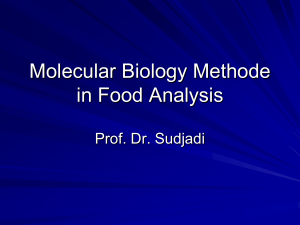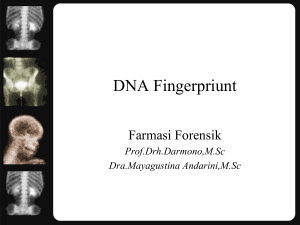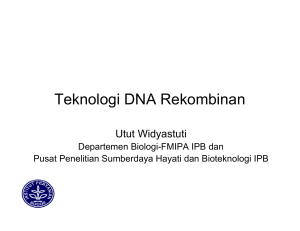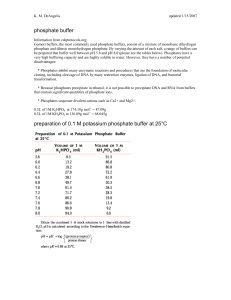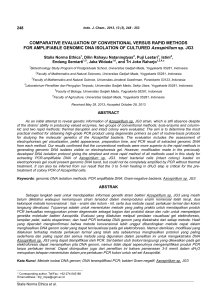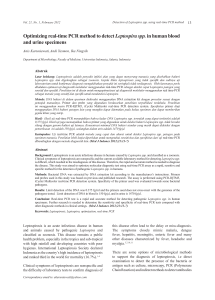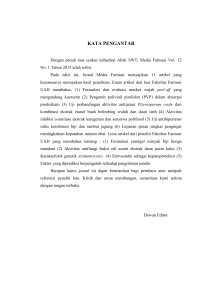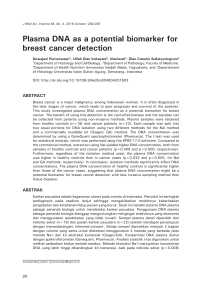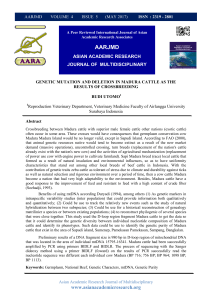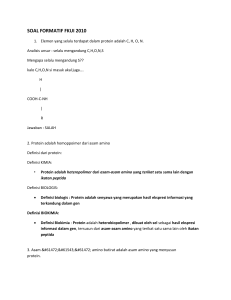Dasar-dasar Pemeriksaan Biologi Molekuler
advertisement
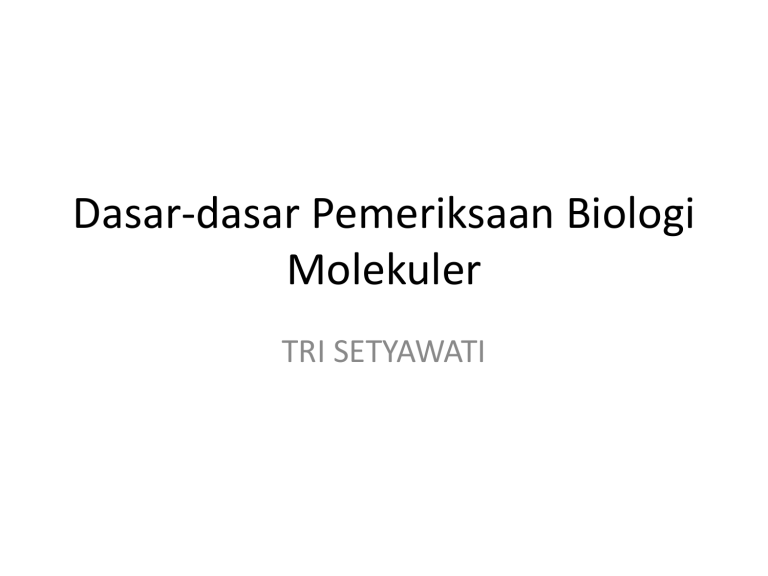
Dasar-dasar Pemeriksaan Biologi Molekuler TRI SETYAWATI 3 teknik dasar dalam biologi molekuler Polymerase Chain Reaction (PCR) DNA Sequencing Cloning EkstraksiDNA DNA Cell structure: Endoplasmic reticulum Golgi apparatus nuclear DNA Ribosome mitochondrial DNA (mtDNA) Mitochondria Telomere 1p32.2 Short arm (p) Centromere Long arm (q) Telomere Jumlah kromosom manusia: - 22 pair autosomal - 1 pair sex Eukromatin (aktif) dan heterokromatin (inaktif) Nukleosom, dasar pembentukan kromatin Prinsip dalam ekstraksi DNA 1. Preparasi sel/jaringan Darah : digunakan leukositnya, eritrosit dilisiskan dan dibuang. Secepatnya diekstraksi untuk mendapat hasil optimal, penyimpanan sebaiknya pada suhu 4 derajat C, penyimpanan yang lama (> 1 bulan) akan menurunkan hasil ekstraksi, volume 3 – 5 ml whole blood Jaringan : secepatnya diekstraksi. Penyimpanan pada suhu -80 derajat. Jaringan yang disimpan dalam paraffin blok sulit untuk diekstraksi 2. Lisis membran sel/organella (nukleus) Phenol : senyawa yang sangat kuat untuk melisiskan membran, tetapi toksik. Guanidine isothicyanate : tidak toksik, digunakan sebagai pengganti phenol 3. Denaturasi senyawa organik Kloroform : paling banyak digunakan karena prosedur sederhana, murah, mudah diperoleh Proteinase K : denaturasi protein, perlu inkubasi 4. Presipitasi DNA Isopropanol dengan volume 1:1 Ethanol absolut dan sodium asetat 1:10 5. Pencucian/washing Ethanol 70% Metode ekstraksi DNA 1. Phenol:chloroform Phenol-choloroform-isoamyl alcohol Metode standard untuk ekstraksi DNA Akhir-akhir ini ditinggalkan, karena sifat toksik phenol 2. Salting Out Menggunakan garam konsentrasi tinggi (NaCl 6 M) Proteinase K untuk denaturasi protein 3. Guanidine isothiocyanate Metode ini lebih cepat dibanding dua metode sebelumnya Thiocyanate bersifat toksik, untuk lisis dinding sel Memerlukan chloroform untuk denaturasi protein 4. Silica Gel Silica gel dapat mengikat DNA dengan perantaraan garam/buffer tertentu (NaI) Cepat, tetapi recovery DNA kurang Pengukuran Kualitas DNA Kualitas DNA Konsentrasi tinggi Utuh, tidak terputus-putus Tidak banyak terkontaminasi oleh protein Menentukan Kualitas DNA Spektrofotometer pada panjang gelombang 260 nm (protein 280 nm; DNA baik apabila pengukuran pada 260:280 = 1,7 – 1,9). Satu OD = 50 ng DNA. Dilihat dengan elektroforesis, band yang tebal secara kualitatif menunjukkan DNA yang bagus Sampel untuk Ekstraksi DNA 1. Whole blood (leukosit : buffy coat) Diambil leukositnya, sebelum itu eritrosit dilisiskan dengan lisis buffer (EBL = erythrocyte lysis buffer). Paling sering digunakan, 3 – 5 ml darah fresh cukup banyak menghasilkan DNA 2. Jaringan biopsi/reseksi (otot, usus dll) Sebelum ekstraksi, lebih dulu diinkubasi untuk menghancurkan jaringan ikat 3. Amniotic fluid/Villi choriales Untuk kepentingan prenatal diagnosis Jumlah DNA yang diperoleh sangat sedikit 4. Jaringan lainnya Untuk kepentingan forensik Jaringan rusak/membusuk/terbakar Folikel rambut, kuku, tulang dll Penyimpanan DNA DNA disimpan dalam TE buffer (tris-hydroxymethyl amino methana – EDTA) Disimpan – 80 derajat bisa tahan bertahun-tahun Untuk kerja, sebaiknya disiapkan DNA yang sudah diencerkan menjadi 100 ng/mikroliter Freezing – thawing berulang dapat meyebabkan kerusakan DNA POLYMERASE CHAIN REACTION (PCR) Adalah teknik penggandaan DNA/amplifikasi DNA DNA isolation/extraction usually produces a very small amount of DNA concentration (several hundreds nanogram / microliter) difficult to analyze It is necessary to amplify DNA / a fragment of DNA PCR allows the production of more than 10 million copies of a target DNA sequence from only a few molecules PCR REACTION MIXTURE 1. Template DNA Usually the amount of template DNA is in the range of 0.01-1 ng for plasmid or phage DNA and 0.1-1 µg for genomic DNA, for a total reaction mixture of 50 µl. Recently, with newest PCR technology, as low as 1 ng of genomic DNA can be amplified. Higher amounts of template DNA usually increase the yield of nonspecific PCR products DNA Quality All methods of DNA isolation (salting out, silica gel, phenolchloroform, guanidine isothiocyanate etc.) from fresh tissue combine with good skills will provide high quality of DNA high concentration, pure, long DNA Trace amounts of agents used in DNA purification procedures (phenol, EDTA, Heparin, Proteinase K, etc.) strongly inhibit Taq DNA Polymerase. Ethanol precipitation of DNA and repetitive washing of DNA pellets with 70% ethanol is usually effective in removing traces of contaminants from the DNA sample. 2. Primers : oligonucleotide which is complement with the flanking region of target DNA sequence There are two primers; forward primer runs from 5’ to 3’ of the sense template, reverse primer runs from 5’ to 3’ of the antisense template PCR primers are usually 15-30 (20 – 25) nucleotides in length. Longer primers provide higher specificity. The primer should not be self-complementary or complementary to other primer in the reaction mixture, in order to avoid primer-dimer and hairpin formation. The melting temperature of flanking primers (forward and reverse) should not differ by more than 5oC. If the primer is shorter than 25 nucleotides, the approx. melting temperature (Tm) is calculated using the following formula: Tm= 4 (G + C) + 2 (A + T) Annealing temperature should be approx. 5oC lower than the melting temperature. If the primer is longer than 25 nucleotides, the melting temperature should be calculated using specialized computer programs where the interactions of adjacent bases, the influence of salt concentration, etc. are evaluated. The optimum annealing temperature should be established from the experiments. 3. Deoxynucleotide triphosphates (dNTPs) dATP, dGTP, dCTP and dTTP) The concentration of each dNTP in the reaction mixture is usually 200 µM. It is very important to have equal concentrations of each dNTP as inaccuracy in the concentration of even a single dNTP dramatically increases the misincorporation level. 4. Taq DNA polymerase Heat stable DNA polymerase, isolated from hot spring bacteria Thermus aquaticus found in Yellowstone National Park, USA. Usually 1-1.5 Units of Taq DNA Polymerase are used in 50 µl of reaction mix. Higher Taq DNA Polymerase concentrations may cause synthesis of nonspecific products. If inhibitors are present in the reaction mix (e.g., if the template DNA used is not highly purified), higher amounts of Taq DNA Polymerase (2-3 U) may be necessary to obtain a better yield of amplification products. 5. MgCl2 The optimal concentration of MgCl2 has to be selected for each experiment. Too few Mg2+ ions result in a low yield of PCR product, and too many increase the yield of non-specific products and promote misincorporation. The recommended range of MgCl2 concentration is 1-4 mM If the DNA samples contain EDTA or other chelators, the MgCl2 concentration in the reaction mixture should be raised proportionally. Concentration of MgCl2 in 50 µl reaction mix, mM Volume of 25 mM MgCl2, µl 1.0 1.25 1.5 1.75 2.0 2.5 3.0 4.0 2 2.5 3 3.5 4 5 6 8 6. PCR buffer Standard PCR buffer contains 50 mM KCl, 10 mM Tris-HCl, pH 8.3 at room temperature PCR Mixture All components should be added one by one in thin-wall PCR tube carefully on ice high probability of mistake Many companies produced PCR mix which contains Taq, MgCl2, dNTPs and PCR buffer in one reagents. Additional components are template and primers only. Final concentration Quantity, for 50 µl of reaction mixture - variable 10X Taq buffer 1X 5 µl 2 mM dNTP mix 0.2 mM of each 5 µl Primer I 0.1-1 µM variable Primer II 0.1-1 µM variable 1.25 u / 50 µl variable 25 mM MgCl2 1-4 mM variable* Template DNA 10pg-1 µg variable Reagent Sterile deionized water Taq DNA Polymerase PCR Conditions 1. Initial Denaturation Step The initial denaturation should be performed over an interval of 1-3 min at 95oC. This interval should be extended up to 10 min for GC-rich templates. The complete denaturation of the DNA template at the start of the PCR reaction is of key importance. Incomplete denaturation of DNA results in the inefficient utilization of template in the first amplification cycle and in a poor yield of PCR product. 2. Denaturation Step Usually denaturation for 0.5-2 min at 94-95oC is sufficient, since the PCR product synthesized in the first amplification cycle is significantly shorter than the template DNA and is completely denatured under these conditions. 3. Primer Annealing Step Usually the optimal annealing temperature is 5oC lower than the Tm; established based on experiments. Incubation for 0.5-2 min is usually sufficient. if nonspecific PCR products are obtained in addition to the expected product, the annealing temperature should be optimized by increasing it stepwise by 1-2oC. 4. Extending/Elongation Step Usually the extending step is performed at 70-75oC. The rate of DNA synthesis by Taq DNA Polymerase is highest at this temperature. Recommended extending time is 1 min for the synthesis of PCR fragments up to 2 kb (or 1 kb). When larger DNA fragments are amplified, the extending time is usually increased by 1 min for each 1000 bp. 5. Final Extending Step After the last cycle, the samples are usually incubated at 72oC for 5-15 min (7 min) to fill-in the protruding ends of newly synthesized PCR products. The terminal transferase activity of Taq DNA Polymerase adds extra A nucleotides overhang to the 3'-ends of PCR products. Cycle Number The number of PCR cycles depends on the amount of template DNA in the reaction mix and on the expected yield of the PCR product. For less than 10 copies of template DNA, 40 cycles should be performed. If the initial quantity of template DNA is higher, 2535 cycles are usually sufficient. Denaturation Annealing Elongation Animasi PCR http://www.youtube.com/watch?v=v4L7rvmBXbY Gel electrophoresis of PCR product (amplicon) Agarose gel is commonly used. Reagents and equipment : gel frame (volume is 40 ml), comb, agarose powder, ethidium bromide and buffer (TBE = tris, boric acid, EDTA) To make 2% agorose gel 40 ml, mix in erlenmeyer tube : Agarose powder 0.8 gram 1 x TBE buffer 40 ml Ethidium bromide 2 µl Heat by microwave for 2 minutes, after cool down pour the mixture on to gel frame equipped with comb. Gel electrophoresis of PCR product (amplicon) Mk 1 2 3 512 bp Unspecific band RESTRICTION ENDONUCLEASE A restriction enzyme (or restriction endonuclease) is an enzyme that cuts double-stranded DNA. The enzyme makes two incisions, one through each of the sugar-phosphate backbones (i.e., each strand) of the double helix without damaging the nitrogenous bases cleave the sugar-phosphate backbone of DNA Thousands of restriction enzymes have been isolated from bacteria, where they appear to serve a host-defense role. Restriction enzymes are classified biochemically into four types (classes), designated Type I,Type II, Type III, and Type IV. Type I and III, both the methylase and restriction activities are carried out by a single large enzyme complex. Both require ATP for their proper function. In type II systems, the restriction enzyme is independent of its methylase, and cleavage occurs at very specific sites that are within or close to the recognition sequence. The vast majority of known restriction enzymes are of type II, and it is these that find the most use as laboratory tools. The first to be discovered and utilized was EcoRI, which is staggered and its recognition sequence is 5'-GAATTC-3'. Most type II enzymes cut palindromic DNA sequences In type IV, the restriction enzymes target only methylated DNA. Restriction enzymes are named based on the bacteria in which they are isolated in the following manner: E : Escherichia (genus); co : coli (species); R : RY13 (strain); I : First identified Order ID'd in bacterium The substrates for restriction enzymes are specific sequences of double-stranded DNA called recognition sequences. The length of restriction recognition sites varies: The enzymes EcoRI, SacI and SstI each recognize a 6 base-pair (bp) sequence of DNA, whereas NotI recognizes a sequence 8 bp in length, and the recognition site for Sau3AI is only 4 bp in length. Different restriction enzymes which have the same recognition site are called isoschizomers (SacI and SstI) Restriction recognitions sites can be unambiguous or ambiguous: BamHI recognizes the sequence GGATCC unambiguous. HinfI recognizes a 5 bp sequence starting with GA, ending in TC, and having any base between (in the table, "N" stands for any nucleotide) ambiguous recognition site. XhoII also ambiguous) The recognition site for one enzyme may contain the restriction site for another. The BamHI recognition site contains the recognition site for Sau3AI. most recognition sequences are palindromes - they read the same forward (5' to 3' on the top strand) and backward (5' to 3' on the bottom strand). Pattern of DNA Cutting by Restriction Endonuclease 1. 5' overhangs: The enzyme cuts asymmetrically within the recognition site such that a short single-stranded segment extends from the 5' ends. BamHI cuts in this manner. The 5' or 3' overhangs generated by enzymes that cut asymmetrically are called sticky ends or cohesive ends, because they will readily stick or anneal with their partner by base pairing. 2. 3' overhangs: asymmetrical cutting within the recognition site, the result is a single-stranded overhang from the two 3' ends. KpnI cuts in this manner. 3. Blunts: Enzymes that cut at precisely opposite sites in the two strands of DNA generate blunt ends without overhangs. SmaI is an example of an enzyme that generates blunt ends. PCR – RFLP (Restriction Fragment Length Polymorphisms) A combination of PCR – restriction method to detect SNP (single nucleotide polymorphsim) The sample is first run in a restriction digest to cut the DNA, then gel electrophoresis is performed on this digest. In the case of MTHFR C677T polymorphism, single band of 198 bp denotes CC genotype, two bands of 198 and 175 bp denote CT genotype and single band of 175 bp denotes TT genotype. After gel electrophoresis, DNA can be visualized by staining with ethidium bromide, an intercalating agent and fluorescent dye. PCR amplification of MTHFR exon 4 G A N T C C T N A G 198 bp G A G C C Ala Enzyme digestion (HinfI) CC (wild type) TT (mutant) ~23 bp G A G T C Val ~175 bp Gel Electrophoresis M CC CT TT 198 bp 175 bp PCR-RFLP untuk polimorfisme G135A gena RET PCR amplification of RET exon 2 Enzyme digestion (EagI) C G G C C G G C C G G C 294 bp ~87 bp ~207 bp Gel Electrophoresis Vietnamese SMA Patients Mk A 3 5 7 8 9 11 19 20 21 22 23 24 C+ CSMN1 Exon 7 SMN2 Exon 7 B C SMN2 Exon 8 SMN2 Exon 8 SMN2 Exon 8 NAIP Exon 5 DNA SEQUENCING The term DNA sequencing encompasses biochemical methods for determining the order of the nucleotide bases in a DNA fragment The advent of DNA sequencing has significantly accelerated biological research and discovery. The rapid speed of sequencing attainable with modern DNA sequencing technology has been instrumental in the large-scale sequencing of the human genome, in the Human Genome Project.

